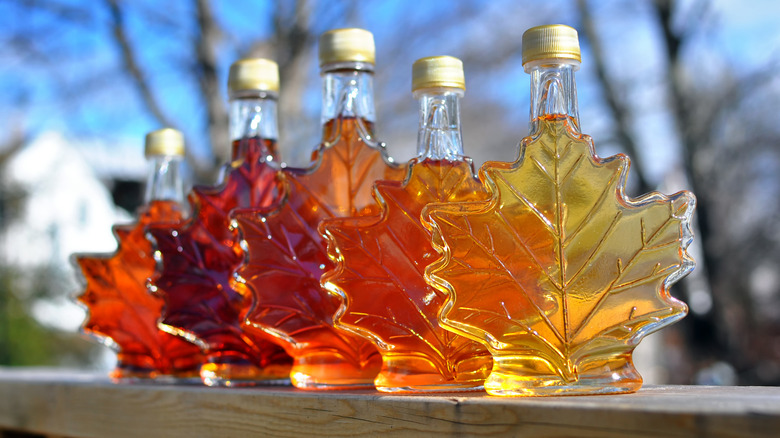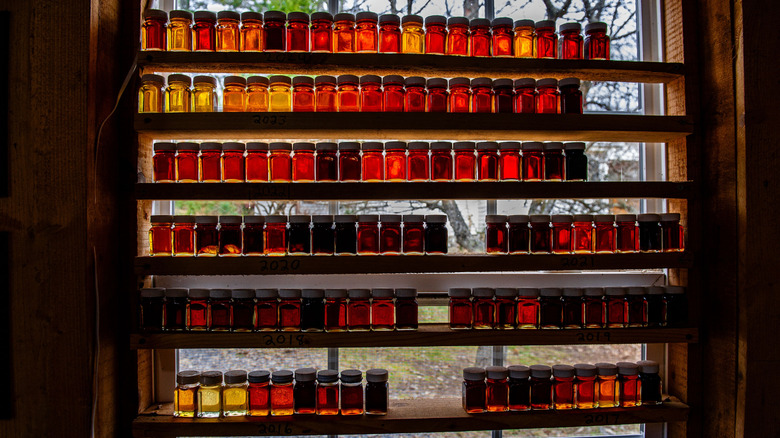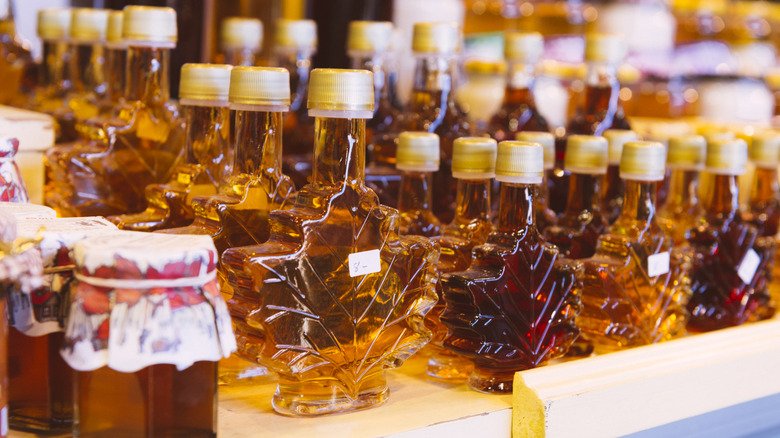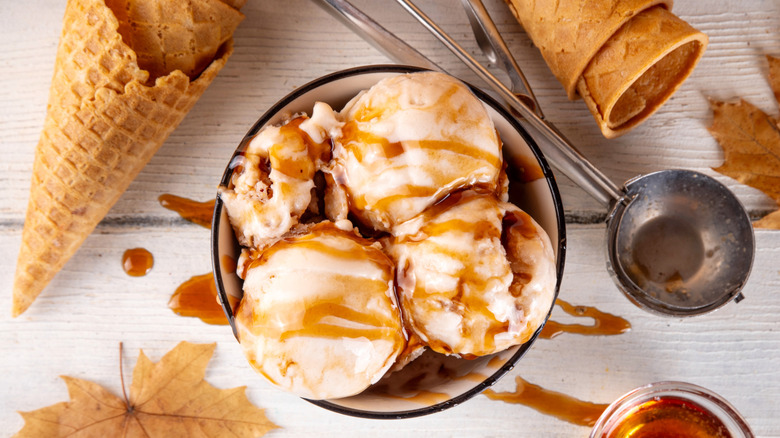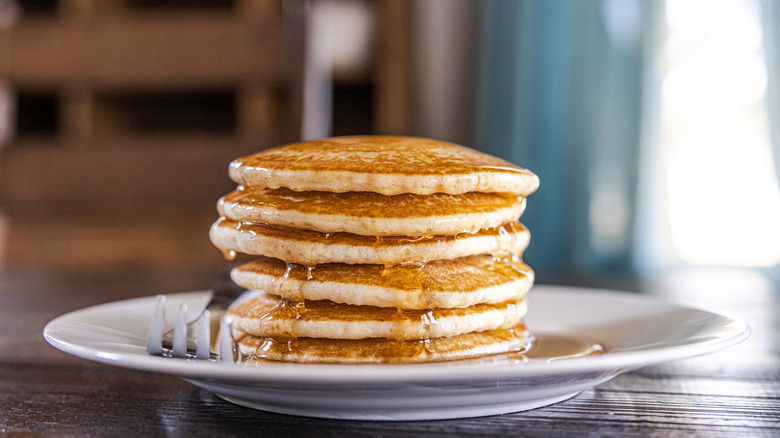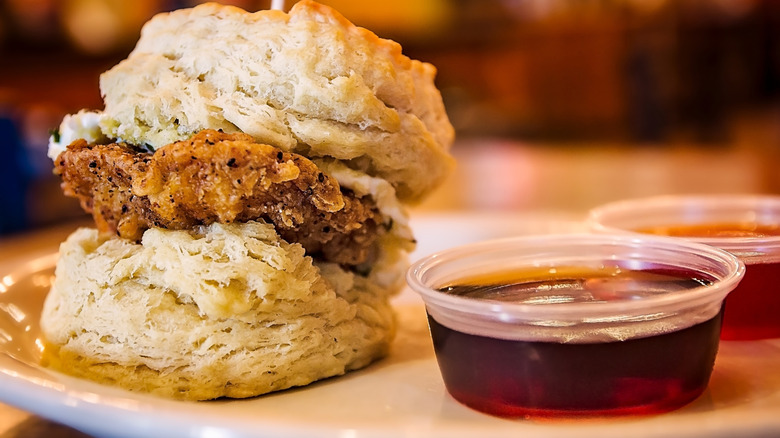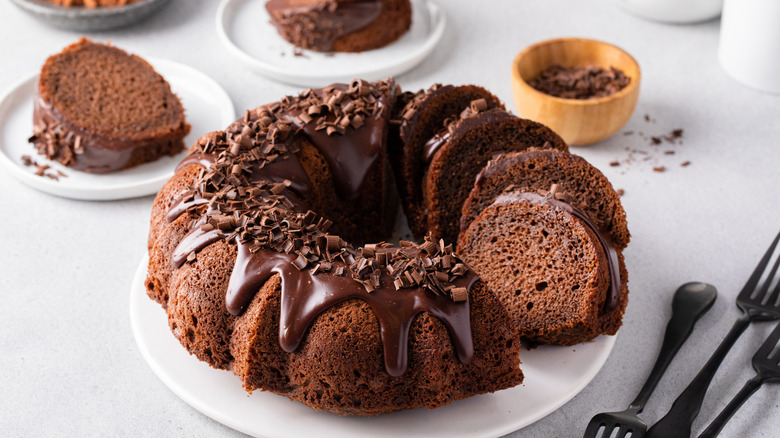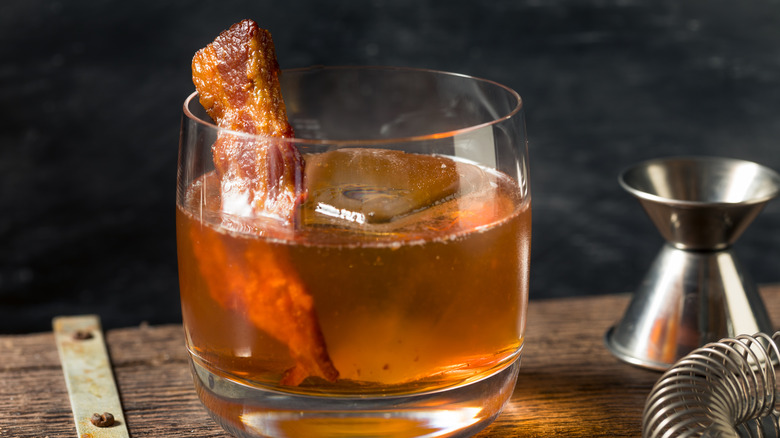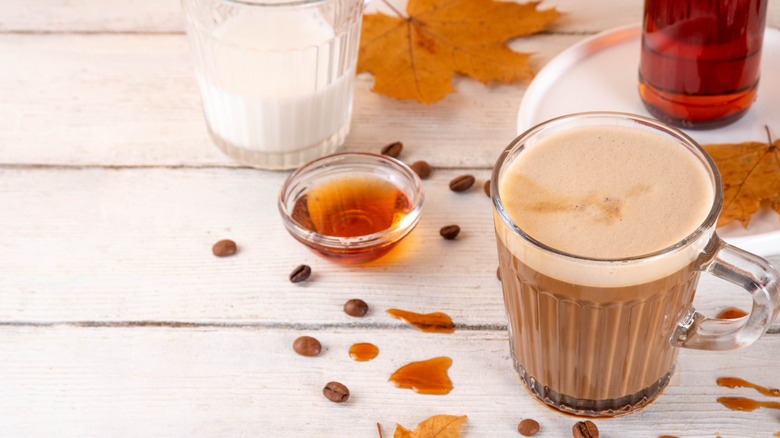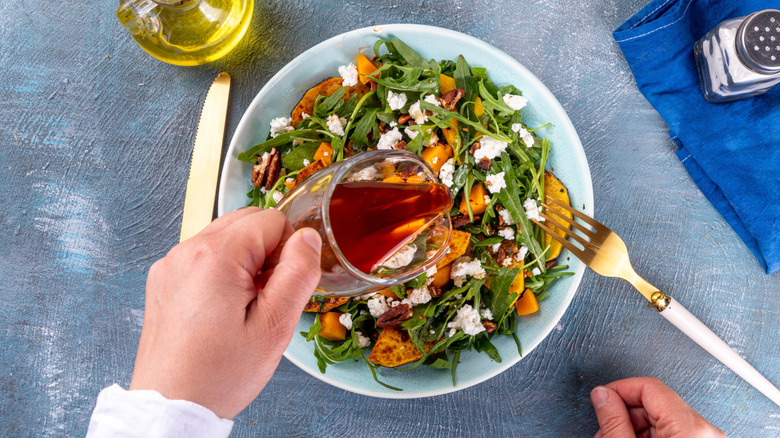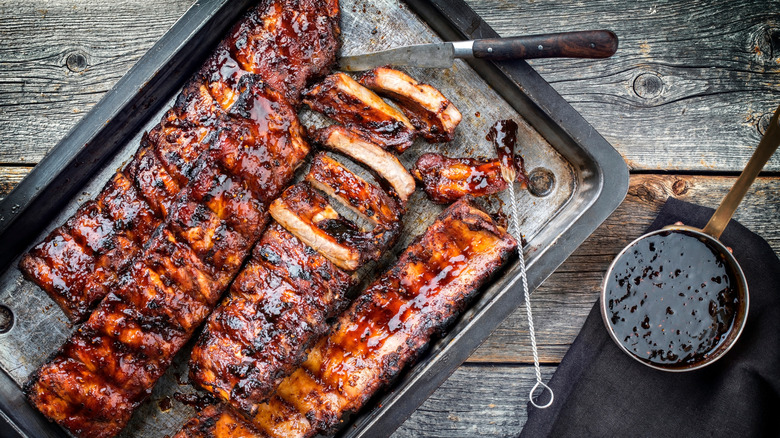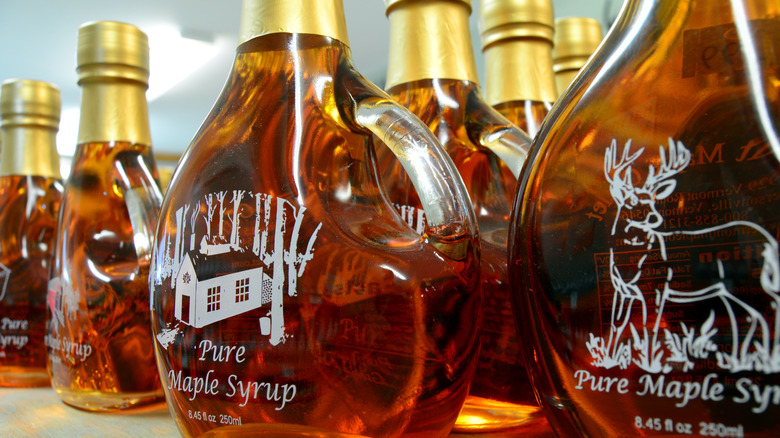The Difference Between Each Grade Of Maple Syrup And How Best To Use Them
When you're perusing your way down the breakfast aisle at the grocery store, you'll be greeted by a plethora of syrup options. Plastic jugs shaped like little women. Glass bottles touting maple leaves and lumberjacks. It's all the same at the end of the day, though, right?
Absolutely not, and if you say this to someone from one of the country's top maple syrup-producing states — Vermont and New York — you're likely to be on the receiving end of an impassioned rebuttal. For maple syrup to be called maple syrup, it must meet the U.S. Department of Agriculture definition of the product, which is, "the liquid food derived by concentrating and heat treating sap from the maple tree." In contrast, anything on the shelf that's just labeled merely "syrup" may have never seen a maple tree in its life and is, most likely, majority high fructose corn syrup or corn syrup.
However, even if you break down the various syrups into the real deal versus the cheap imitations, true, authentic maple syrup still has its own nuances and variations. Maple syrup is separated into four grades, each grade with its own distinct color, flavor profile, and best uses. Here's what you need to know.
Maple grades are based primarily on syrup color
Today, maple grades are based on syrup color, but that wasn't always the case. Maple grades were only standardized in 2015. Prior to this, the grading process would differ from state to state, and you'd see syrups labeled everything from "fancy grade" to "Grade A" to "Grade B." However, don't make the mistake of thinking that Grade B was somehow lesser than Grade A; Grade B just had a different flavor profile than Grade A. Still, syrup producers realized that these grading systems could be confusing and misleading, so a national standard was adopted.
The four maple grades are: Golden, Amber, Dark, and Very Dark. Typically, you can rely on every Golden maple syrup to have a similar flavor profile, every Amber maple syrup to have a similar flavor profile, and so forth. That said, sometimes a batch of maple syrup differs slightly, and the colors and flavors don't quite match up. In these instances, producers will assign the syrup the darkest grade that it adheres to.
Additionally, if you want to get technical, when producers are looking at the color of maple syrup, they're not so much looking at the actual hue, as they are the amount of light that can pass through the syrup, aka light transmission. Golden maple syrup transmits more light than dark maple syrup.
Each maple grade has a distinct flavor profile
As mentioned, each grade of maple syrup comes with its own, distinct flavor profile. The lighter the color, the more delicate the flavor. The darker the color, the more intense the flavor.
As such, Golden, which is the lightest maple syrup in color, also has a more subtle flavor profile. Typically, Golden syrup is harvested early in the sugaring season and it may carry undertones of vanilla, in addition to its very light maple flavor. Amber is next, and it's typically what most people think of when they think "maple flavor." Expect the absolute classic maple flavor, shining through at its purest, no imitations. Dark maple syrup cranks things up just a notch, with more forward, in-your-face maple flavors. In fact, while Golden and Amber-graded maple syrups do have those underlying notes of flavors like vanilla, when you get to Dark maple syrup, you don't really get those. It's all maple, all the time.
Lastly, there's Very Dark maple syrup and it's, as you could probably guess, the most intense of all. While many may like Very Dark maple syrup, it can be an acquired taste, and you're not going to find it offered at a restaurant alongside your waffles. It's more likely to be used in broader dishes.
Golden syrup is best paired with other sweet flavors
So, how can you best use each of these grades of maple syrup? If you're working with Golden-graded maple syrup, keep in mind its light, delicate flavor profile. This means not pairing the Golden syrup with anything that's going to overwhelm it or drown it out. However, it also means that you can pair Golden syrup with other sweet flavors, without ending up with a dish that tastes like pure sugar.
For example, some like to keep Golden maple syrup on hand for drizzling over ice cream. If that sounds like a little too much sweetness to you, keep in mind that the maple syrup pros in Vermont actually have a well-known dish called the "maple creemee," which is basically maple soft-serve ice cream — and since they're the top-producing maple syrup state in the country, they can't be wrong. Another Vermont-favorite, cold maple treat is "sugar-on-snow," made by pouring 235-degrees Fahrenheit maple syrup onto fresh snow; as the syrup hardens, you can roll it up onto a popsicle stick and enjoy.
Still, if you're looking for something that trends slightly healthier, add Golden syrup to your vanilla yogurt. Think of pairing it with your breakfast bowl of Greek yogurt and granola, instead of honey. You may find that you also like it on your waffles or pancakes, if the lighter maple flavor appeals to you, but it's not going to give you the classic pancakes-and-maple-syrup experience.
Amber syrup is the most versatile and classic
If you do want that really classic undeniable maple flavor, you'll find that Amber-graded syrup is the way to go — as well as the most versatile maple syrup grade overall. You can pretty much add this maple syrup to every meal, which means that if you're not looking to drop a ton on pure maple syrup (anyone who's ever been in the market for some knows it can get pricey), this is the singular maple syrup you want to buy.
While other grades of maple syrup may be best suited to cooking or baking, or pairing with certain savory or sweet foods, Amber syrup can hold its own in most situations, so long as you remember that you're not going to get the delicate, light flavor profile of Golden syrup, and you're likewise not going to get the robust, intense flavor profile of Dark or Very Dark syrup.
Looking for a really unique and versatile way to use Amber-graded syrup? Use it as the unexpected ingredient in your egg salad. Drizzle in some maple syrup as you stir all your other ingredients together, tasting as you go. Use the maple syrup in place of any other sweetener in your egg salad recipe, such as sugar or sweet relish.
Dark syrup pairs well with smoky or spicy flavors
Dark syrup works really well with savory — particularly smoky or spicy — flavors, thanks to its own more robust, yet still sweet, flavor profile. This is the maple syrup you want to reach for if, for example, you want to make a glaze for a holiday ham, or if you're wanting to roast some veggies in a spicy maple glaze.
Other potential great uses? Put together a smoky or spicy barbecue sauce by pairing maple syrup with ketchup and bourbon, plus chili powder, red pepper flakes, or hot sauce. For an even smokier flavor than what the bourbon will provide, add in some liquid smoke. You can also add a dash of sweetness and spice to your instant ramen, by adding a little Dark maple syrup and chili flakes to the mix. Don't forget to add butter as well, for a creamier instant ramen experience.
If, though, all this talk of a smoky-sweet flavor profile is making your mouth water and you want to branch out to other, similar syrups, consider buying a bottle of hickory syrup. Hickory syrup is made by toasting hickory tree bark, boiling it to create an extract, and then adding simple syrup to that extract and cooking it all down until it reaches a maple syrup-like consistency.
Very Dark syrup is best for baking and cooking
Using maple syrup in baking projects, as a stand-in for sugar and often for health reasons, is hardly abnormal for many home cooks. However, you've probably noticed that if you do this, it really doesn't give your baked item that much of a strong maple flavor. This is because lighter grades of maple syrup, like the ones you're most likely to have in your kitchen, aren't going to carry that distinct maple flavor through the baking process. They can certainly add depth and interest to your baked item's flavor profile, but you're unlikely to take a bite and think "Mm, maple!"
If that's what you're going for, though, you'll want to opt for Very Dark syrup, which easily holds that strong maple flavor in cakes, cookies, breads, and more. It's also a favorite for maple baked beans, again, because this is a dish that you want to distinctly taste of maple, and Very Dark syrup will retain that flavor over long cooking times.
Looking for unique ways to use Very Dark maple syrup in your baking? Try adding maple syrup to your boxed cake mix in place of the water called for on the back of the box. It's going to be a very sweet result, but also a very delicious one, especially if you pick a spice cake mix with its warm spices.
Golden syrup is great for cocktails
When you add maple syrup to a cocktail, you want it to add a nice maple note, but you also don't want to feel like you're simply drinking watered down maple syrup. As such, consider adding Golden-grade maple syrup to your next boozy beverage of choice. You can really use maple syrup in any cocktail that uses simple syrup by just swapping out one for the other. For example, you could use it in place of simple syrup in a New York Sour, an Old Fashioned, gin fizz, or an espresso martini.
But what if you want to do the inverse and instead of infusing your cocktail with maple syrup, infuse your maple syrup with booze? It can be done! All you have to do to booze up your maple syrup is combine a cup of maple syrup with a few tablespoons of whiskey or rum on the stove. Either let the mixture come to a boil to cook off the actual alcohol, or turn off the heat as soon as you add the alcohol to the warm maple syrup to preserve that boozy kick. From there, add it to your pancakes or waffles (just maybe wait until you're having breakfast for dinner?), or use it anywhere else you might like a dash of spirited maple flavor.
Pour Amber syrup in your coffee
Yes, you really should be putting maple syrup in your coffee. If you currently just add plain sugar to your morning cuppa joe to sweeten it, you could really be missing out on some more complex flavor profiles. Sugar and similar sweeteners only add just that to your coffee drinking experience — sweetness. Maple syrup, meanwhile, adds more depth, richness, and warmth, without being cloyingly sweet (so long as you take it slow and add only a little syrup at a time, tasting as you go).
Additionally, compared to some other coffee sweeteners, maple syrup could be a more healthful choice. While maple syrup still comes with a fair amount of carbs and calories, it does have a lower glycemic index than traditional, refined white sugar, and it boasts antioxidants, too. Plus, just a tablespoon of maple syrup contains about a third of your daily recommended allotment of manganese, a mineral that supports your nervous system and immune system.
As for which grade of syrup you choose to pair with what type of coffee, consider pairing Amber syrup with Central or South American-washed coffees that are either a light or medium roast. Luckily, since Amber-grade syrup is the standard variety you'll find at most breakfast tables, you likely won't have to look too hard or far to find some.
Use Dark syrup in your salad dressings
Dark maple syrup works well in homemade salad dressings, adding enough maple flavor to ensure you can still taste it, even as you work in other, distinct ingredients such as vinegars. If you want to use maple syrup in your homemade salad dressing, just replace any sugar that your recipe calls for at a 1-to-1 ratio. If your recipe doesn't call for any sugar, add maple syrup to taste, sampling as you do, until you've achieved the sweetness you desire without negatively impacting your salad dressing's consistency.
Even if you're not making a homemade salad dressing, maple syrup is one of the ingredients you can look out for on store-bought salad dressings' ingredients lists to determine if you have a quality salad dressing on your hands. All good salad dressings will include an acid, salty ingredient, sweetener, and umami element. Maple syrup can appear as the sweetener. As for acids, look for vinegar or citrus. Salt, capers, and miso all appear as salty ingredients, while fish sauce and Parmesan can provide an umami kick.
Very Dark syrup works well in marinades and on meats
As the maple syrup with the strongest flavor, Very Dark syrup should be your go-to for marinades or sauces, or anything along those lines that you really want to use to infuse a cut of meat with more flavor. While it's not really preferred for eating as a topping like Amber-grade maple syrup is, Very Dark syrup is ideal for long cooking or prep times, whether you're marinating a piece of meat overnight or you're smoking it low and slow over the course of an entire day.
Not sure where to start in adding Very Dark syrup to your meat without completely obliterating the other flavors? Try making a maple syrup marinade by swapping the honey in an existing marinade recipe for maple syrup. Additionally, choose your meat wisely. As versatile as maple syrup is, it doesn't work all that well with beef, but it's a great choice for a variety of other proteins, including salmon, pork, and even game. In fact, the flavors of Very Dark syrup could be just the thing you need if you're trying to reduce the gaminess of duck or squab. (And if you're not a meat eater, you can also use Very Dark syrup as a glaze or marinade for roasted vegetables such as pumpkin and butternut squash.)
Individual states may have their own maple syrup requirements
As you're shopping for the perfect maple syrup to add to your pantry, keep in mind that while these four maple syrup grades — Golden, Amber, Dark, and Very Dark — are pretty much the nationally accepted standard, some states may have their own maple syrup requirements. While these requirements may not impact the maple syrup grade on the bottle, they may impact other qualities, such as the thickness of the maple syrup or what maple producers are allowed to print on their packaging. These requirements are in place in large part to ensure consumers know exactly what they're buying and can easily identify authentic, real maple syrup.
However, if you're just in the grocery store, shopping for the best store-bought maple syrup possible without heading to your local sugar shack (if you're even lucky enough to have one in your area), it's not always as easy as you'd hope to pick the real deal out of the bunch. While you may now know to steer clear of anything that just says "syrup" or that lists artificial flavors or "maple flavor" on the packaging, you also need to avoid anything that says "natural maple flavor." This means the manufacturer managed to replicate the maple flavor using natural ingredients, rather than naturally sourcing the maple flavor from a maple tree.
